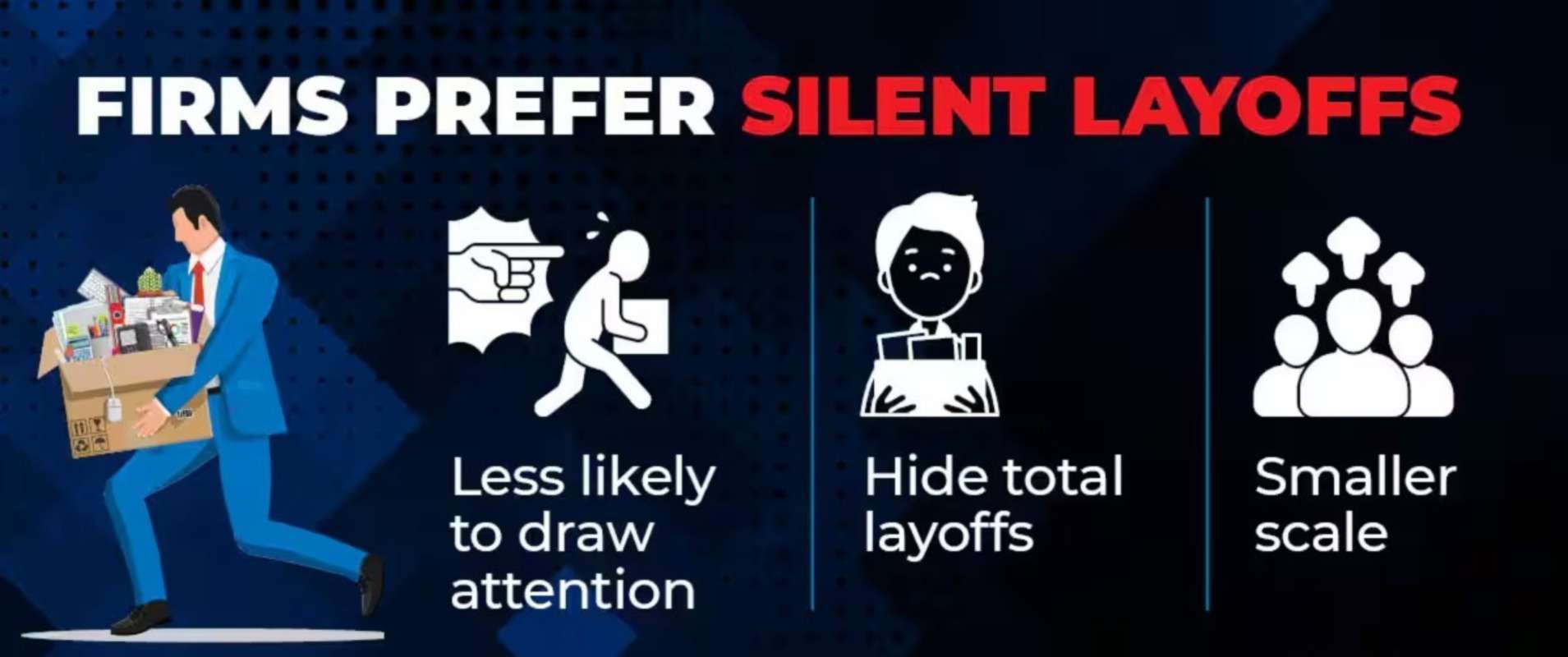Companies Are Doing Mass Layoffs: Should You Be Worried?

The dreaded notice of dismissal from employment can be an impending disaster in one’s career. Layoffs can undoubtedly result in an identity crisis, mental strain, and even medical consequences at a personal level, as they can shatter financial stability, evoke “why me” feelings, and trigger unimaginable personal anguish.
However, it is important to remember the cascading effect it has on economies. Layoffs have the potential to alter the social, political, and economic fabric of affected economies, ranging from reduced consumer spending and tax revenues to increased government spending (in economies that provide unemployment benefits) and long-term economic scarring.

Mass layoffs have occurred and/or are ongoing in a variety of industries worldwide, including tech giants like Google, Amazon, Meta, Dell, and Microsoft, retail giants like Walmart and McDonald’s, financial megastars like Wells Fargo, Barclays, Goldman Sachs, Citi, and Morgan Stanley, consulting giants like Bain & Company, Accenture, KPMG, and Deloitte, and manufacturing heavyweights like General Motors and 3M.
The list of companies reducing their workforce in response to the escalating economic uncertainties is increasing everyday. It even affects lesser businesses and start-ups in various sectors, such as Fintech, crypto, enterprise SaaS, transportation, digital media, etc.
The global technology sector is experiencing one of its most distressing years in recent history, with nearly 2,40,000 employees laid off thus far in 2023. In addition to technology companies, the warehousing, transportation, construction, manufacturing, wholesale trades, and real estate sectors are also on the brink of significant employment losses if they have not already commenced.
Silent Mass Layoffs
A minimum of 130 Indian startups have laid off an estimated 37,264 employees since the outset of the funding winter in 2022.
14,816 employees have been terminated by nearly 25 Indian edtech firms, which includes all seven edtech unicorns.
The situation regarding employment cuts has not significantly improved, as evidenced by the fact that six startups have terminated over 755 employees thus far this year.
According to an association, Indian companies, particularly those in the information technology (IT) services sector, are “quietly firing” or “silently sacking” employees. This term refers to unfavorable conditions that compel individuals to resign independently.
By avoiding severance compensation for resigning employees, the strategy assists companies in reducing costs. Additionally, it intentionally fosters a deteriorating work environment, including overwork, stalled promotions, and a lack of support.
The Harvard Business Review stated that redundancies are a substantial expense for companies that must provide severance packages when terminating employees. Microsoft’s second-quarter earnings last year included a $1.2 billion expense due to redundancies and other restructuring initiatives.
This trend is also gaining traction in India. In 2023, the IT/ITeS sector experienced “silent” redundancies that resulted in the loss of approximately 20,000 technical employees, as the All India IT & ITeS Employees’ Union (AIITEU) reported. These reductions impacted all sizes of IT services companies.
Various warning indicators, such as changes in work responsibilities, compensation, working conditions, and supervisor communication, can be used to identify quiet firing. When an employer engages in silent firing, they may reassign significant job responsibilities to other employees, demote an employee, or modify their job description.
Additionally, the impacted employees may discover that they are not designated promising new opportunities or are given unreasonable performance objectives. In certain instances, they may be assigned duties that are either unfavorable or inconsistent with their position, or they may be denied a promotion that they have earned.
In terms of compensation, quiet termination tactics may involve:
- Pay reductions.
- Preventing employees from earning more by requiring them to work additional hours or overtime.
- Failing to provide the anticipated annual bonuses or raises.

Changes in working conditions may also indicate a quiet dismissal. This may entail the modification of work hours or regular shifts, the accumulation of unmanageable workloads, the requirement for an employee to relocate, or the removal of benefits such as an office or parking space.
Another critical area in which signs of quiet dismissal can manifest is communication with supervisors. Employees may discover that their career trajectory is no longer being discussed or not receiving performance feedback.
‘Ghosting’ and Unfair Evaluations
Excessively severe feedback or consistent criticism of their work may result in evaluations that are perceived as unjust. The employee may encounter “ghosting,” which involves the repetitive cancellation of meetings or the failure to provide them with essential information regarding their work and responsibilities.
Additionally, their achievements may not be recognized, or, in the worst-case scenario, recognition for their efforts may be given to others. These warning signs collectively suggest a strategy of quiet firing, which has the potential to undermine an employee’s position and encourage them to depart voluntarily.
Organizations terminate personnel contingent upon their operational circumstances. Teradata, a cloud analytics and data platform company headquartered in San Diego, terminated approximately 35-40 employees at its Hyderabad campus after the previous year. This follows the termination of approximately 1,100 employees worldwide in 2022. According to LinkedIn, Teradata has a workforce of over 10,000 individuals worldwide.
Reason For Mass Layoffs
The COVID-19 pandemic prompted a quick transition to online work mode and compelled technology companies to engage in a recruiting frenzy to meet the demand.
These organizations have chosen to decrease their workforce due to a variety of factors. Even though companies are attributing redundancies to restructuring initiatives and a focus on efficiency, reports indicate that the genuine reasons include overhiring, a declining economy, and, most importantly, the growing influence of AI.
The emergence of Artificial Intelligence (AI) is particularly intriguing for organizations that are interested in optimizing efficiency and reducing costs. Nevertheless, AI not only automates certain tasks but also generates novel opportunities in the fields of artificial intelligence and machine learning.

However, the post-pandemic realities are proving to be distinct from the initial expectations, necessitating that businesses promptly adapt to the current circumstances, including:
- Market Uncertainties Arising from a High Degree of Globalization accompanied by geopolitical unrest in various regions of the world
- Decreased consumer spending as a result of declining demand for specific products or services
- Traditional roles becoming redundant as a result of the adoption of remote and hybrid work models
- Cost-cutting measures to either mitigate pandemic time losses or enhance performance and profitability
- Production and revenue generation are being affected by supply chain disruptions.
- Consumer behavior is being permanently altered, necessitating personnel adjustments in affected industries due to an increased reliance on digital services.
Should Indians Be Concerned?
Yes, we cannot circumvent the current situation’s global repercussions. Layoffs are comparable to economic catastrophes that generate shockwaves that spread globally, and India, as an emerging economic superpower, will not be immune to the consequences.
Ban Ki-moon, the former Secretary-General of the United Nations, once commented, “In the interconnected web of global commerce, layoffs in one corner of the world reverberate throughout, exposing the fragility and interdependence of our economies.”
There will be repercussions in various sectors of our economy due to India’s significant influence in the global labor market:
- Increased Job Market Competition: The global layoffs have resulted in a significant increase in job market competitiveness in India, which has, in turn, contributed to a higher unemployment rate and greater challenges for job seekers.
- Decreased Export Demand: The worldwide economic deceleration has reduced the demand for Indian exports, which has hurt the country’s trade balance. The situation is further exacerbated by numerous countries’ implementation of protectionist measures in response to the pandemic or other political factors.
- Pressure on Domestic Industries: Domestic industries are under significant pressure to maintain their competitiveness in the face of the current economic circumstances as a result of the reduced demand for Indian exports and increased competition from their international counterparts.
- Reduced Remittances: Indian citizens who have lost their employment abroad are unable to provide the same level of remittances as before to support their families in India. The Indian economy is negatively impacted by the general decline in remittances, which are a substantial source of foreign exchange and account for approximately 3% of our GDP.

- Tumbling FDIs: Additionally, the government’s FDI policy reforms have increased transparency and opened up strategically significant sectors for 100 percent FDI under the automatic route. Despite the fact that this action resulted in the highest-ever FDI inflows of USD 84.84 billion in 2021-22, the inflows decreased by approximately 16% in the first half of the current fiscal year as foreign investors adopted a cautious stance in response to the global economic slowdown, which caused employment losses across sectors.
Impact of Mass Layoffs
In addition to the reductions in consumer spending, tax revenues, and remittances, sectors such as e-commerce and technology that function as the back office or outsourcing operations for global companies may experience substantial job losses in India.
The reduced demand and depleting purchasing power in international markets may result in growth and sustainability issues for sectors that are heavily dependent on exports. A reset in our real estate sector is a possibility if global companies with offices in India reduce their expenditures for the spaces they maintain or exchange large offices for smaller facilities.
Instances of rent defaults and delays may also occur, resulting in a financial crisis for commercial landlords.
India was responsible for approximately 11% of the global unemployment in 2022; however, this figure had decreased to 4% by early 2023.
The reason for the relatively lower job cuts in India compared to the global average is that international companies perceive our stable economic condition as a positive indicator that they can continue operations without significant reductions.
In reality, numerous recruitment consultants and executive recruiting firms have suggested that numerous global corporations are considering the relocation of their downsized operations to India to achieve greater cost efficiencies. Therefore, the impact of the global layoffs in India may be primarily limited to IT product and service companies, with newcomers in this sector being the most susceptible.
| Cisco | Cisco laid off more than 4000 employees as part of a restructuring initiative. |
| Snapchat |
Snapchat laid off its personnel as part of cost-cutting measures in response to revenue generation challenges and the decline of the digital advertising market. The company has announced its intention to reduce the size of its global full-time personnel by approximately 10% to concentrate on its primary objectives and stimulate future growth. |
| Nokia | Nokia is currently engaged in a substantial organizational restructuring, which includes the elimination of more than 10,000 positions on a global scale. Tarun Chhabra was recently appointed as the new head of Nokia India, reporting to Tommi Uitto, the president of Mobile Networks, as part of this restructuring endeavor.
In October 2023, Nokia announced a broader initiative to restructure its business and reduce its global workforce by 11,000-14,000 positions. This initiative aims to enhance operational efficiency and adapt to market dynamics. This move is consistent with this initiative. |
| PayPal | Additionally, the online payments company reduced its workforce by 9%, equivalent to approximately 2,500 employees, as part of its efforts to reduce personnel. |
| In January, Google announced two distinct cycles of layoffs, following mass layoffs and smaller-scale job cuts. This aligns with the 2024 trend of layoffs. The initial announcement of redundancies affected more than 1,000 employees in various divisions, including Pixel, Fitbit, Nest, and Google Assistant. However, the latter is expected to affect several hundred individuals in the sales and advertising unit. In an internal memo, CEO Sundar Pichai indicated that additional role eliminations are anticipated this year to enhance execution and velocity in specific areas. | |
| YouTube | Separately, YouTube, Google’s video platform, has announced the termination of 100 employees as part of a restructuring initiative. |
| Microsoft | Microsoft has announced additional job cuts in January, reportedly laying off 1,900 employees from Xbox and Activision Blizzard, following a succession of job cuts in 2023. According to The Verge, this represented approximately 8% of the Microsoft Gaming division’s personnel. |
| Amazon |
In reaction to the changing market landscapes, Amazon has implemented substantial reductions across its various divisions. Audible, an online audiobook and podcast service, is reducing its workforce by 5%, while Amazon Prime Video is terminating several hundred employees in its streaming and studio operations. Furthermore, Twitch, Amazon’s broadcasting platform, is reducing its workforce by 35%, which will impact approximately 500 employees. Regarding figures, Amazon’s Buy with Prime division has recently reduced its workforce by approximately five percent. The company has also announced eliminating hundreds of positions in its Pharmacy and One Medical divisions. |
| Unity | Unity Software, a prominent provider of video game software, is laying off its workforce by approximately 25%, or 1,800 positions. |
| eBay | eBay disclosed its intention to reduce its workforce by 9% by laying off 1,000 employees. The company attributed the terminations of employees to the obstacles presented by the current economic climate. |
| Discord | According to an internal memo from the company’s founder and CEO, Jason Citron, the messaging platform Discord is also reducing its workforce by 17%, affecting approximately 170 positions. |
| Riot Games | In a recent post, Riot Games, the publisher of prominent game titles such as Valorant and League of Legends, announced that it has laid off 530 employees, which represents 11% of its workforce. The purpose of this action is to concentrate on high-impact projects. |
| Salesforce | Salesforce has also announced 700 employment cuts, which represent approximately 1% of its 70,000 global workforce. |
| TikTok | TikTok The advertising and sales division of the short video platform TikTok recently terminated 60 employees; however, the rationale for the terminations remains undisclosed. |
| Flipkart | Flipkart, the Indian e-commerce colossus owned by Walmart, also joined the list after announcing its intention to reduce its workforce by 1,000 employees as part of its annual performance evaluation. This represents approximately 5% of the organization’s workforce, which is presently estimated to be around 22,000 employees. |
| Swiggy | Swiggy Another Indian-based company, Swiggy, is also purportedly announcing a restructuring initiative that will result in the termination of 400 employees. This is the organization’s second round of reductions, affecting approximately 7% of its workforce. |
| Wipro | Wipro also joined the list of tech companies that are instituting workforce reductions on January 31. The company is in the process of reducing “hundreds of mid-level roles onsite” to improve its margins. |
| Byju’s | Byju has laid off 6500+ employees, consisting of 13% of its workforce, as a part of its cost-cutting and restructuring exercise in the face of allegations of mismanagement. |
Google, Microsoft, Meta, and other organizations are actively involved in the development and deployment of AI models, which has resulted in an increase in the demand for professionals with the necessary skills in these disciplines.
This trend is underscored by a recent report by CompTIA, which indicates that there were 33,727 active job postings in the relevant field in January 2024. This increase has been the most significant month-over-month increase in the past year.
Preparing for turbulence, Indian companies must implement decisive measures to alleviate the economic instability that will result from the impending global redundancies. This encompasses the following:
- Embracing digital transformation and innovative technologies to improve operational efficiency.
- Investing in employee reskilling and upskilling to maintain workforce adaptability amid increased job market competition.
- Establishing strategic alliances, both domestically and internationally, to pool resources and expertise can be crucial in addressing economic challenges.
- Implementing compassionate leadership, lending emotional support, and offering flexible work arrangements to increase employee engagement and productivity.
- Most importantly, it is imperative that we maintain our agility and quickly adjust to the evolving market dynamics. This is the most certain way of guaranteeing resilience and competitiveness in uncertain times.
In reality, these global economic conditions provide us the chance to become more sustainable, innovative, and adaptable. By concentrating on these critical strategies, businesses in India will not only survive the tempest but also establish themselves as leaders in the changing global economic landscape.



